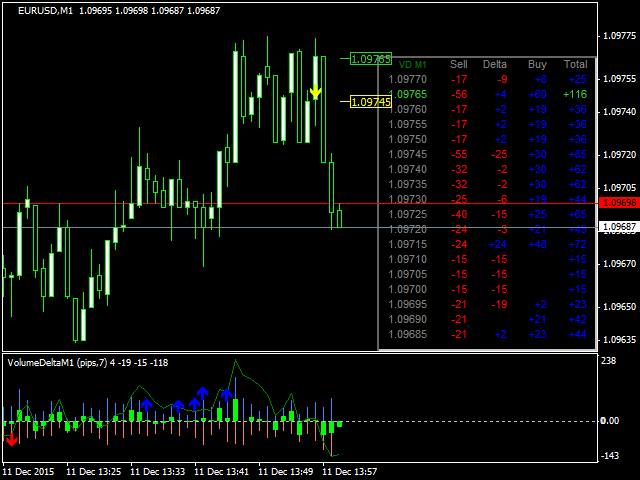This indicator analyzes the deltas of tick volumes. It tracks the up and down ticks and calculates the tick volumes for purchases and sales (separately), as well as their difference. In addition, it displays volumes broken down by price clusters (cells) within the specified period of bars. VolumeDeltaM1 was created in addition to the VolumeDelta indicator, which uses similar algorithms, but does not process ticks and therefore cannot be used on M1. VolumeDelta can show data on any history, because it reads volumes from M1 and translates them to higher timeframes, and VolumeDeltaM1 collects statistics of ticks online on M1 and can display its data only for those slices where ticks were collected and saved in special files (1 file per day).
The indicator can also work on higher timeframes, reading the data collected on M1. At the same time, only reading from the file is performed, and to write new ticks to the file, an instance of the indicator on M1 is still required.
This is a limited replacement for market delta analysis, which is traditionally based on real volumes, but they are not available in Forex.
This is a limited replacement for market delta analysis, which is traditionally based on real volumes, but they are not available in Forex.
[spoiler title=”Read More…”]
The indicator displays graphs of the following data in its subwindow:
- light blue histogram – purchase volumes;
- orange histogram – sales volumes;
- light green histogram – the difference between purchases and sales;
- the green line is the cumulative delta, smoothed by the EMA difference; it is increased by a CumulativePeriod of times to maintain a roughly equal scale with the histograms;
- blue and red arrows-mark those bars where the direction of the volume delta contradicts the direction of the price, which can serve as a signal for short-term trading on the next bar.
The indicator also displays a table of split volumes for the last CumulativePeriod bars in the main window. The table rows correspond to the price clusters. The table contains the following columns:
- price (range from the specified value to the next one at the top);
- sales volume;
- delta between purchases and sales (positive-blue, negative-red);
- purchase volume;
- total volume (cells with values near the maximum are highlighted in green).
- FileNamePrefix-prefix in the file name with tick statistics; the file name has the structure: VDM1[T|P] – Prefix-Symbol-YYYYMMDD.csv; by default-empty; T or P means the Mode used (see below);
- Mode – ticks or pips; in ticks mode, only the number of price changes is counted, in pips mode, the size of each change in points is taken into account;
- TesterReadOnlineData , false means the tester is similar to online; if true, the indicator reads the data from the existing. csv files that need to be copied to the tester/files from MQL4/Files; this mode allows you to see in real tester data; Note: the 0-th bar is always recalculated generated by ticks, but at the moment when he becomes the first data is read from a file;
- PointsPerCell – the number of points in a single price cluster; each cluster is displayed as a separate row in the table of split volumes (this is a kind of analog of the “Time and Sales” feed”);
- CumulativePeriod – cumulative delta calculation period, EMA;
- ShowTable-enables / disables cluster table output;
- ShowMark-enables / disables the output of price labels for clusters with the maximum total volume (green) and the maximum delta (yellow);
- ShowAskBidInTable-enables / disables highlighting of table rows corresponding to the current Ask and Bid prices;
- Corner – the corner of the main window where the table will be displayed; 1 – upper right; 0-upper left; 2-lower left; 3-lower right;
- cellWidth – width of table cells;
- cellHeight – height of table cells;
- ColorBG – table background color;
- FontSize – font size in the table;
- Method-switch for the method of categorizing ticks; If the value is ask_versus_bid, the volumes refer to buying when the ask price increases and to selling when the bid price decreases. On some accounts, bid price changes are broadcast more often than ask, which leads to a downward bias. To solve this problem, you can choose the ask_and_bid option, which analyzes changes in the ask and bid amounts.
Valid timeframes: M1 (full-function mode), M5 and higher (reading data from M1).
[/spoiler]





